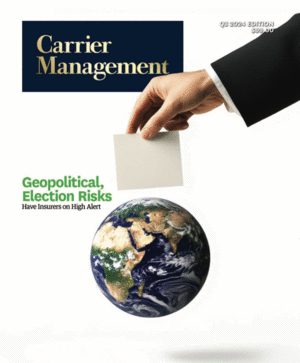Executive Summary
Recognizing the barriers to success in microinsurance, eight insurance entities came together with a unique business model to share the cost of innovation and mutualize talent from within and beyond the industry. Here CEO Joan Lamm-Tennant describes the mission and the model of Blue Marble Microinsurance.The underlying mission of Blue Marble is tied to economic development and the recognition that insurance is important to economic development around the world. Without prefinancing losses, societies are vulnerable. Following disasters, people who show potential for emerging into the middle class frequently fall back to the bottom of the economic pyramid.
With the knowledge that fortifying the economic progression of the poor would add untold benefits to the global economy, to our industry and, of course, to the poor themselves, we asked another simple question: What needs to change in the insurance and reinsurance industry to make it relevant to the poor?
To examine this question further, Blue Marble’s founders needed to be open-minded about doing things differently and having a willingness to learn while leading. Only by researching the facts could Blue Marble articulate the problem that the founders set out to solve and establish a mission backed by a business model. The problem was clearly identified in research literature.
For example, Swiss Re reported that in the last 10 years cumulative total damage to global property as a result of natural disasters was $1.8 trillion—only 30 percent of which was insured—resulting in a protection gap of $1.3 trillion. This gap is even wider when general property risk such as fire, water damage and burglary are considered. And the gap is likely to continue to widen due to trends such as global warming and urbanization. While this research covers a scope broader than microinsurance, we have identified the significance of the protection gap and its ever increasing trend.
Other research has underscored how uninsured losses eventually become the responsibility of governments and society at large, resulting in a drag on the economic growth of nations. In emerging nations, 80-100 percent of disaster losses are uninsured, according to Swiss Re. Haiti, the poorest country in the Western Hemisphere, is an example that warrants examination. 
The United Nations World Food Programme reports that 75 percent of Haitians live on less than $2 a day. In January of 2010, the dire situation was worsened by a magnitude 7.0 earthquake. According to the Inter-American Development Bank, about 230,000 people died and nearly 1.5 million Haitians were displaced. Economic losses were estimated at about $8 billion, approximately 120 percent of GDP, with insurance penetration at around 0.3 percent of GDP.
In another example—the recent earthquake disaster in Nepal—we estimate the damages at 35-50 percent of GDP, with little to no aid delivered as of yet. The effect of the protection gap on developing nations and the consequence on the poor is crippling.
The poor, with no safety nets other than informal systems of caring for each other, are disproportionately impacted by catastrophes. The safety nets break down in a village or community following a disaster, thrusting complete communities to the bottom of the economic pyramid for years to follow. In Nepal, communities rich with heritage and dependent on tourism are now struggling to survive with a safety net under stress. Without mechanisms for prefinancing risk, smallholder farmers, shop owners and artisans who lack savings fall deeper into poverty.
With an understanding of the problem Blue Marble planned to address, a business case for the consortium was established. The problem was viewed as significant and the solution relevant to the global economy, our industry and the poor.
A Role for the Insurance Industry
The potential solutions include charity and public-private partnerships, but what role might the insurance industry assume? While some companies have attempted to enter the microinsurance market in hopes of providing risk protection to the poor, few actually succeeded. Some have been able to show profitability, but most lacked evidence of the double bottom line: the ability to deliver protection that also incentivizes and enables the poor to make better economic choices in their lives.
This is a crucial point. Risk protection, in and of itself, will not enable economic progression. Incentives embedded in the risk protection are the key drivers. Policies should be designed to encourage growth and expansion. For example, by creating a more certain outcome, a policy can enable the smallholder farmer to cultivate two hectors of land as opposed to one hector. Another example is enhancing a micro-entrepreneur’s willingness to expand his or her sewing business—to buy another sewing machine and hire an employee—all enabled by a reduction in the fear of theft.
Making It Work
A review of prior experiences—many unsuccessful—suggested that Blue Marble needed a different business model. The business model needed to recognize the vast array of talent required to address the protection needs within the context of poverty entrapment. From within the insurance industry, expertise was needed to support product development, regulatory environment and risk pricing. Other areas of expertise likely found outside of the industry included an understanding of the poverty ecosystem and how to partner with entities in the supply chain of the poor.
At the same time, the business model had to address the many barriers to success in microinsurance:
- A long-term commitment was needed, yet our traditional business models were anchored on immediacies and benchmarked against such metrics as payback periods.
- Financial literacy and trust needed to be established.
- High distribution costs result in prohibitive frictional cost, making the protection unaffordable. The cost of innovation to address this frictional cost was high.
- Lastly, it was critical to understand why the poor consistently made suboptimal economic choices even when given access to the means.
Recognition of the barriers to success in microinsurance and the need for a unique talent model led Blue Marble to a collaborative approach: the formation of a legal entity owned by eight significant insurance entities with a dedicated management team supported by employees from the consortium members. Through collaboration, we would share the cost of innovation and be able to “mutualize” talent from within and beyond the industry. By stepping forward and collaborating among the eight, we developed a public-private outreach partnership with a shared goal.
Blue Marble was established as a legal entity owned by the eight but with a long-term focus. A dedicated management team was retained to give focus to the problem at hand and was backed by a governance model involving senior leaders from the consortium members.
The talent model was unique. The eight consortium companies represent 250,000 employees operating in 170 countries. A virtual business unit was established giving Blue Marble access to talent from the consortium members on a secondment basis. The win-win is that Blue Marble has access to both strategic and technical talent on an as-needed basis. For example, if a Spanish-speaking actuary with knowledge of agriculture risk in Peru is needed, we can identify them and, through the virtual business process, gain access to their expertise for a limited time. Likewise, Blue Marble facilitates reverse benefits in terms of employee engagement and an appreciation for the relevancy of our day-to-day work.
Why the Name Blue Marble?
Employees of all participating companies were informed about the microinsurance consortium initiative and their ideas for names were solicited. The communication heads for each company coordinated the outreach and then narrowed the submissions. The board ultimately selected “Blue Marble.”
The name was nominated by Denise Addis, executive assistant from Guy Carpenter. Addis wrote: “Blue Marble is a nickname for our planet…Technology and social media have made the world an even smaller place, and the planet itself has become a community more than ever before. I think this venture will expand that community.”
The name captures our holistic view of our world. Underscoring our mission to extend insurance protection to a broader portion of the population and to advance the role of insurance in society in a socially responsible and sustainable way, it reminds us that we all share the planet. It is up to us to connect with citizens around the world to make life better for us all.





















 How to Innovate in Homeowners Insurance
How to Innovate in Homeowners Insurance  GenAI: Why Many Insurance Companies Are Getting It Wrong
GenAI: Why Many Insurance Companies Are Getting It Wrong  How to Grow Profitably in Seven Steps: Sharpening Risk Appetite is One
How to Grow Profitably in Seven Steps: Sharpening Risk Appetite is One  How an Iowa Mutual Insurer Recovered From Financial Storms
How an Iowa Mutual Insurer Recovered From Financial Storms 






